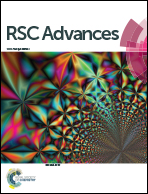Coumarin-based supramolecular gelator: a case of selective detection of F− and HP2O73−†
Abstract
Coumarin appended 1,2,3-triazole coupled cholesterol 1 which acts as a small molecular gelator has been designed and synthesized. Compound 1 has been noted to form gel from CHCl3–petroleum ether (1 : 1, v/v). The stable gel is anion responsive. The gel state is transformed into the sol state selectively in the presence of F− and hydrogen pyrophosphate and thus validates their visual sensing over a series of other anions. Fluorescence study in CH3CN containing 0.5% DMSO also reveals substantial change in emission of 1 upon addition of both F− and hydrogen pyrophosphate and distinguishes them from other anions studied.


 Please wait while we load your content...
Please wait while we load your content...